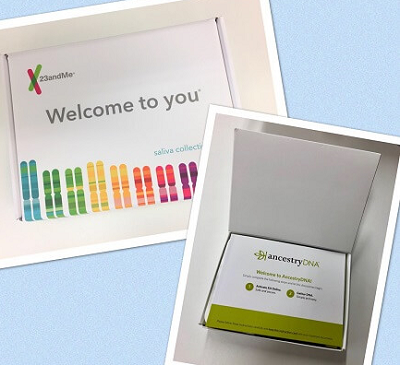
23andMe vs. AncestryDNA
Of all the genetic ancestry services, 23andMe and AncestryDNA have become household names. Both have databases in the millions, with more and more people getting tested each year. Of the two, Ancestry.com boasts the largest database, containing more than 10 million people, while 23andMe has more than 5 million. This means that if you are looking for genetic relatives, Ancestry’s database is the more likely place to find them.
Each company uses their own reference populations and algorithms to calculate ethnicity estimates, and both allow you to discover genetic relatives. Ancestry.com is primarily an online genealogy service, allowing access to birth, death, marriage records, etc., for an ongoing subscription. 23andMe, on the other hand, specializes both in ancestry analysis and genetic health reports. Their service is focused less on building a family tree, and more on discovering what your DNA can tell you about yourself.
Quick Info – 23andMe vs. AncestryDNA
☑ 5 million+ in database
☑ Results in 6-8 weeks
☑ 150+ worldwide regions
☑ 570,000 genetic markers (for ancestry)
☑ Family finder
☑ Neanderthal traits
☑ Health reports
☑ Download raw data
☑ 10 million+ in database
☑ Results in 6-8 weeks
☑ 350 worldwide regions
☑ 700,000+ genetic markers
☑ Family finder
☑ Family records search
☑ Genealogy subscription
☑ Download raw data
Ordering the DNA Kit – 23andMe vs. AncestryDNA
Both 23andMe and Ancestry DNA kits can be purchased online, through their websites. The price of shipping is included with 23andMe, though not with Ancestry. (Return shipping for each is included.)
Both kits come in well-presented boxes, and so would be suitable to give as gifts. Each test requires a saliva sample, and comes with instructions for using the saliva collection kit, activating the kit online, and returning your DNA sample to the laboratory.
For each, you can typically expect your results in 6-8 weeks after your sample reaches the lab.
☑ Saliva collection kit
☑ Results in 6-8 weeks
☑ Free outward shipping
☑ Free return shipping
☑ Saliva collection kit
☑ Results in 6-8 weeks
☑ Free return shipping
What to Expect from Your Ancestry Results
Both 23andMe and Ancestry DNA tests produce an ancestry report, viewable via an online account. However, the way these results are presented is rather different, and both 23andMe and AncestryDNA have a few of their own exclusive features.
So…
Here’s What to Expect from 23andMe
The main focus of 23andMe’s ancestry results is the ancestry map and percentage breakdown of the ethnicities that contribute to it.
The 23andMe ancestry map
This map is interactive. Clicking on the different regional percentages will zoom in on different parts of the part, and give a little information about each region. If you connect with your genetic relatives, the percentages may shift somewhat, since your parents may carry more genetic markers belonging to certain populations than you do. Ancestry percentages may also be altered due to updates.
There is also an ancestry timeline, giving an approximation of when certain ancestors entered your family tree, based on the genetic markers you have. The 23andMe results also feature a chromosome painter, showing how your ethnicity markers are spread over the 23 pairs of chromosomes that make up your DNA. This is a pretty advanced tool, though could be useful for those interested in genetics.
With 23andMe, you can also trace your maternal and paternal haplogroups; i.e., your direct maternal and paternal lines. Both men and women can trace their maternal line (mother’s mother’s mother, etc.) from the mitochondrial DNA they inherit from their mother.
The 23andMe maternal haplogroup map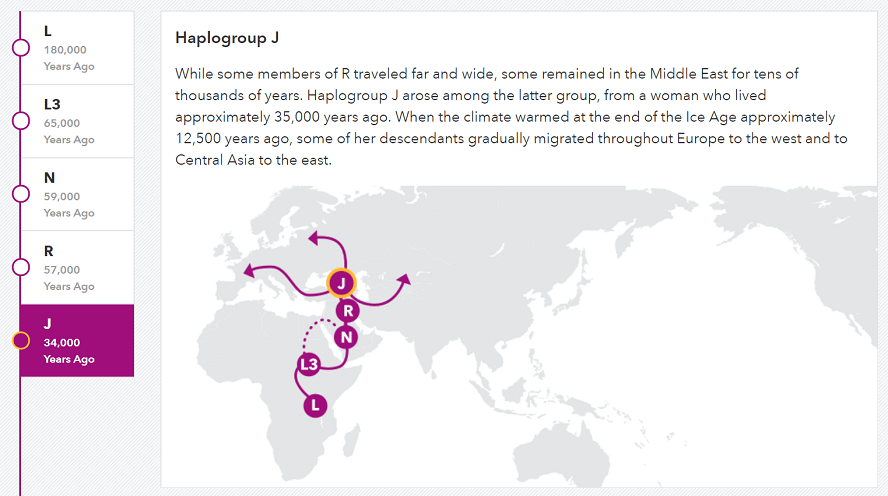
Only people born biologically male can trace their paternal line (father’s father’s father, etc.) since this is traced using the male Y chromosome. (However, people without a Y chromosome can trace their paternal line by connecting with their father, brother, paternal uncle or paternal cousin.
For each haplogroup, there is a timeline and map showing the migrations of your haplogroup over the centuries. Since mitochondrial DNA (mtDNA) and Y-DNA are passed down directly mother to daughter and father to son with mutations occurring very rarely, they can show the routes your ancestors took either out of or within Africa.
You can also discover whether you have any Neanderthal DNA and how much you have, and which traits may have been influenced by this early human heritage.
Here’s What to Expect from AncestryDNA
Like 23andMe, Ancestry’s DNA test produces a DNA Story map, highlighting the regions where you are likely to have inherited DNA, and providing ethnicity estimates for each region.
The Ancestry DNA Story map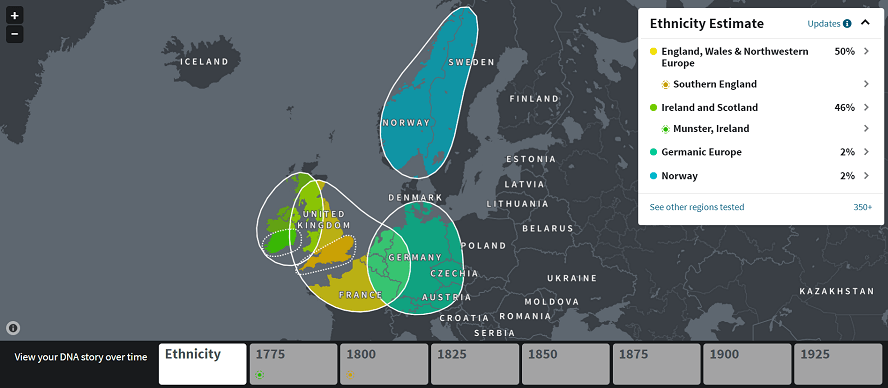
The map also shows how the peoples from these regions migrated over time. If you combine the DNA service with Ancestry’s genealogy service, the timeline along the bottom can also be used to show when your ancestors entered your family tree.
An AncestryDNA map showing ancestors born around 1875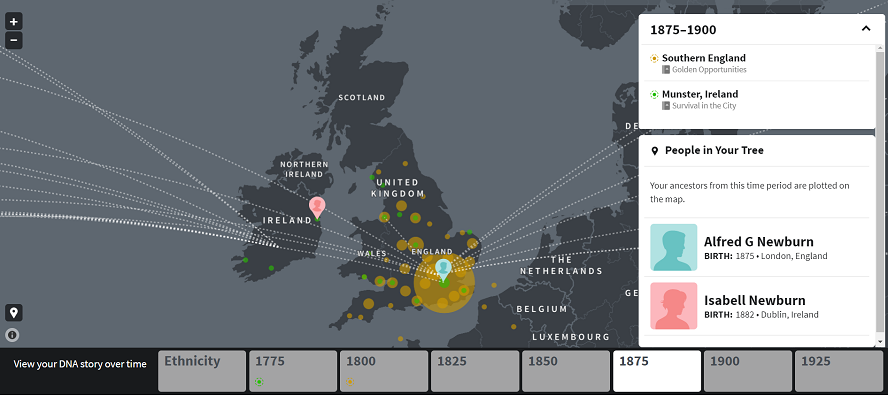
Ancestors that feature in your family tree will be flagged on the map when you click on the time period when they were alive.
The more populated your family tree, the more ancestors you will be able to trace using the ancestry map.
Connecting with your genetic relatives can refine the map further by showing your Genetic Communities. For instance, if you inherited a significant amount of Irish and Scottish DNA, and if many of your relatives come from Munster in Ireland, this could be highlighted as a Genetic Community for you, since it’s likely that your ancestors came from this area.
Finding Relatives – 23andMe vs. AncestryDNA
23andMe and AncestryDNA both offer a family finder service. This allows you to connect with your living relatives, and offers estimates of how related you are. Most people will have quite a few third to fourth cousins, and even more fourth to sixth cousins. Some people will have even closer relatives in the database.
For both 23andMe and Ancestry, the family finder service is optional. If you choose not to opt in, your profile will not be visible to other users.
23andMe: DNA Relatives
The family finder tool offered by 23andMe is called DNA Relatives. When you opt into DNA Relatives, you can choose how much information you wish to share, including your name, overlapping DNA segments, and your ancestry composition results.
The 23andMe DNA Relatives section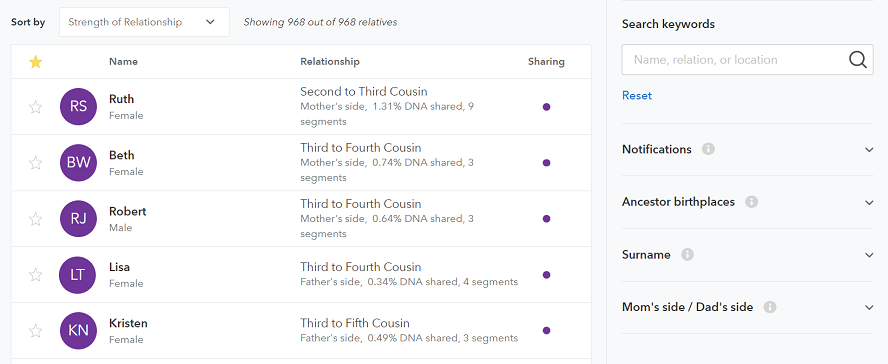
When creating a profile, you can choose how you wish to display your name: whether just initials, your full name, or your first name, and so on. You can enter information about where you live and where your grandparents were born, if you have Ashkenazi Jewish ancestry, and your ancestors’ surnames. You can also share a link to an external family tree, and write a short bio.
Once you have created a profile, you will be able to view a list of your DNA matches, which are automatically sorted by strength of relationship. However, you can use filters like surnames, ancestor birthplaces, or whether they are related to you on the mother’s or father’s side to sort your matches.
You can contact your DNA relatives, and invite them to share their ancestry results or to view the DNA segments you have that overlap. It is possible that 23andMe users may be less responsive than Ancestry.com users, since many of them are principally interested in the health reports.
You can alter your preferences or stop participating in DNA Relatives at any time.
AncestryDNA: DNA Matches
The Ancestry family finder tool is called DNA Matches. If you choose to opt into DNA Matches, you can choose whether to display your real name or username, and whether you want your matches to be able to view your full ethnicity profile and the Genetic Communities you belong to.
The Ancestry DNA Matches section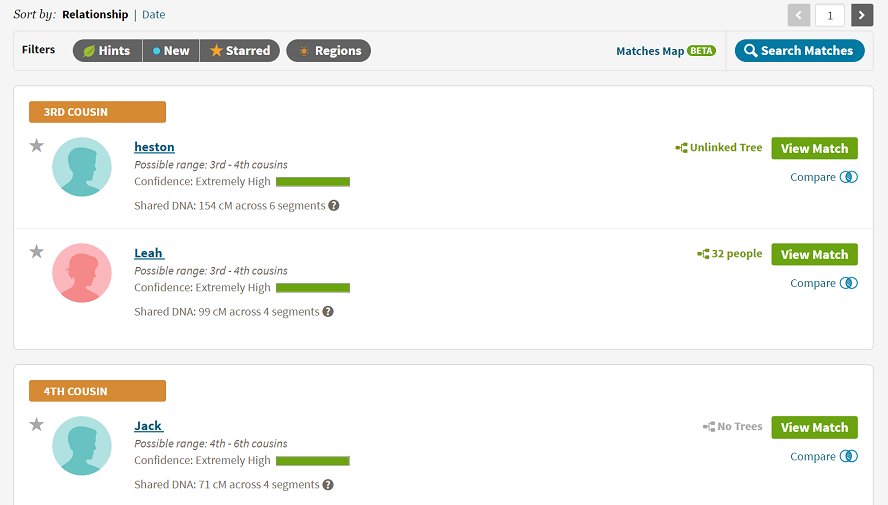
These DNA Matches are sorted by how related you are, though you can also search by surname or birth location, or filter by Genetic Community region. You can view as much of your matches’ ethnicity profiles as they choose to share, see when they last logged in (an indication of their activity and responsiveness), view your shared matches, and send them a direct message.
If you are also subscribed to Ancestry’s genealogy services, then you can also compare family trees and surnames, which makes it easier to work out precisely how you are related. As with 23andMe’s service, you can change your preferences or opt out at any time.
As Ancestry is genealogy-oriented and many users use the platform for building family trees, AncestryDNA users may be more responsive to messages than 23andMe users. As the database is larger, you may also be more likely to discover relatives using AncestryDNA.
Other Features – 23andMe vs. AncestryDNA
23andMe: The Health Report
In addition to their ancestry services, 23andMe also offers a health report, which can be bought in conjunction with the ancestry report, or as an upgrade.
A snippet from the 23andMe traits section of the health report
The health report contains genetic predispositions to certain diseases, carrier statuses, some genetic health traits, and certain physical and other traits. As the health reports contain predispositions to serious conditions such as breast and ovarian cancer, Alzheimer’s and Parkinson’s disease, you can choose whether or not you wish to view these results.
The health reports also contain wellness-related traits pertaining to things like sleep behavior and caffeine consumption, and also more miscellaneous traits like hair color, fear of heights, and whether you like coriander.
If you connect with your immediate relatives, you can also view which of these traits you share, and which parent you inherited them from.
AncestryDNA: Genealogy Services
Ancestry’s DNA services can be combined with their formidable genealogy database, containing birth, death and marriage records and census information. Many users of Ancestry.com have built up vast family trees, and so it is likely that many users new to the service will have a third or fourth cousin who has already filled certain branches of their family tree for them!
An example of an Ancestry family tree entry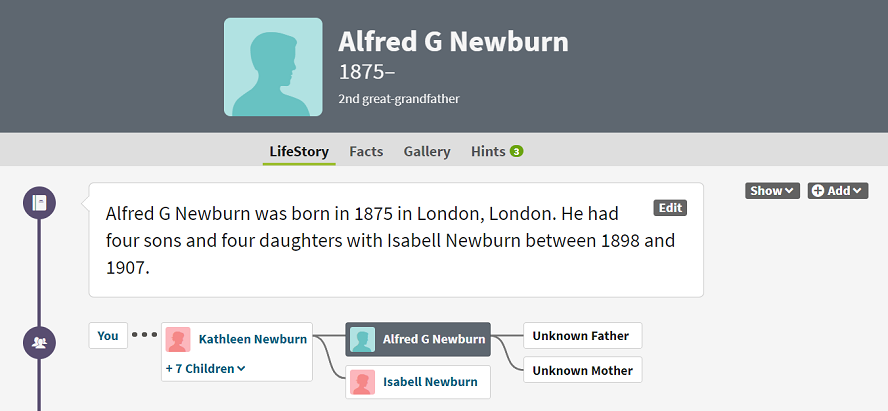
Combining the DNA and genealogy services can allow users to trace the arrival of different ancestries into their family tree, and follow their families’ migrations, births, marriages and stories to find out how they wound up where they are today.
Of course, the genealogy aspect of Ancestry.com comes with an ongoing price tag. However, if you get a free trial, then you may find that you can build up a fairly comprehensive family tree. There are free records and family tree building services elsewhere, though perhaps not with the convenience of Ancestry.com, where everything can be found in one place.
Data Protection – 23andMe vs. AncestryDNA
Both AncestryDNA and 23andMe take considerable steps to ensure the security of their clients’ personal data, including their DNA data.
The Short…
☑ Server encryption
☑ Consent to research
☑ Aggregated data sharing
☑ Server encryption
☑ Consent to research
☑ Aggregated data sharing
The Long…
How 23andMe Protects Your Data
Once your genetic data has been processed by 23andMe, you can choose to have your saliva sample destroyed. You can also choose to delete both your data and your 23andMe account at any time (which is permanent and cannot be undone). 23andMe encrypts their users’ data while at rest, and uses HTTPS encryption to protect it while in transit.
When creating your 23andMe account (and at any time after), you can choose to opt in or out of research by 23andMe and approved third party researchers. If you choose to participate, your genetic and other data (like responses to research questions) will be aggregated (stripped of identifying information and grouped together with lots of other data) so that you cannot reasonably be identified.
However, even if you don’t choose to contribute to research, your aggregated data may still be used for research and shared with third parties. In their Privacy Policy, 23andMe states they may share aggregate information such as “30% of our female users share a particular genetic trait,” without sharing data or testing results specific to any individual user.
How Ancestry Protects Your Data
In the Ancestry.com privacy policy, they state that they only share genetic data with researchers once the user has given informed consent to research. Like 23andMe, they may still disclose aggregated data, such as statistics to which your data has contributed, but which contain no personal information whatever.
You can close your account and request the deletion of your genetic data (which would be completed within 30 days). You can also contact Member Services to ask for your DNA sample to be destroyed. However, if you have shared family tree information with other Ancestry members, they would still retain this information, and you would have to contact them personally if you’d like them to delete it.
Like 23andMe, Ancestry.com uses secure server software to encrypt genetic and personal information.
So, which is better?
The question of whether 23andMe or AncestryDNA is better really comes down to what you are looking to get from an ancestry DNA test. If your DNA quest is principally about looking for genetic relatives or researching your family tree, then AncestryDNA is probably the better test for you.
For those interested in their genetic health information as well as ancestry, 23andMe’s health and ancestry service would be ideal. Since 23andMe has the second largest database after Ancestry, it is still possible for users to find lost relatives, though they may have to engage in more genealogical sleuthing, or upload their data to GEDmatch (which Ancestry users can also do) to increase their chances.
So, for those looking to learn more about what their DNA can tell them about themselves, I recommend 23andMe. For those looking to learn more about their living relatives and ancestors, I recommend AncestryDNA.
Asanda kwinana
January 6, 2021
Im 31 years female from burgersdorp Eastern cape,My mother doesnt want to tell who is my father.so i love to know that guys can you help please

Lorna Carroll
April 27, 2019
In February 2018 I submitted a saliva sample and received from My Heritage DNA, a map of the world with my ethnicity breakdown. That was interesting, but what I was particularly looking for was the identity of my real father. Both the man who acted as my father and the man who others tell me is my (real) father are both deceased. It would be useful and helpful to me and my children to know our true heritage. Please advise how I can discover the identity of my true father.
With thanks, Lorna.